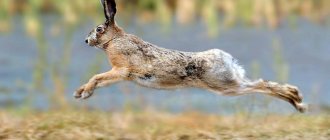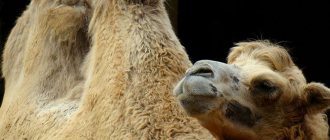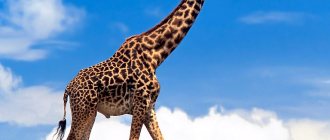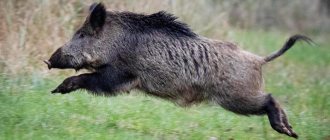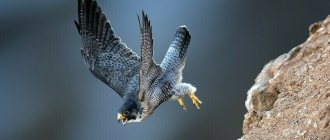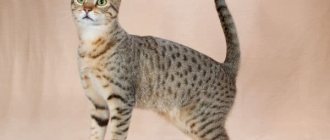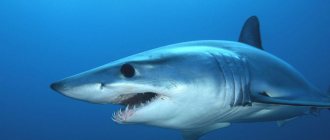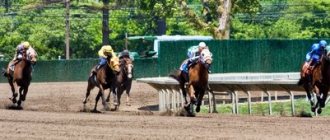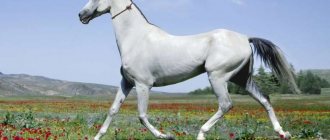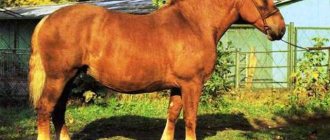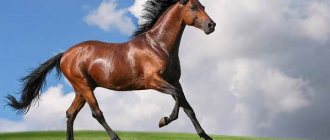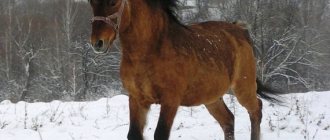Livestock » Horses
0
1994
Article rating
Kira Stoletova
Anyone who has ever been to a hippodrome knows that a horse develops quite a lot of speed. This indicator depends on many factors. Let's look at what a horse's speed depends on. We will also take a look at the statistics and find out the average and maximum speeds recorded to date.
Horse speed
Types of speed
The running speed of horses is directly related to the breed and build of the animal, however, the main types of movement speed are distinguished:
- working - the most comfortable and less tiring manner of movement, as a rule, does not exceed 4–5 km/h;
- medium is a more accelerated pace, develops when moving at a trot. Typically the average is 13–16 km/h, but some racing breeds can reach speeds of up to 20 km/h;
- maximum is the maximum speed that an animal can develop. As a rule, this species can only be seen in competition conditions. Maximum limits are individual for each breed.
Ways of walking
In addition, what speed a horse develops directly depends on the type of step.
distinguish these types of gaits (step types)
- Walk (slow gait)
- Trot (gait, accelerated at two tempos)
- Short trot (trot)
- Field lynx
- Swinging trot
- Gallop
The normal running of a horse is called a gallop - this is how most horses run at average speed.
Several breeds were specially bred that were capable of trotting; these breeds are called trotters. But still, the fastest way to move a horse is a quarry. It is also called accelerated gallop. Not every gallop can move from a gallop to a quarry. Animals with the “ambling” type of step are even less common.
Such horses are called pacers. Pacers are found among many horse breeds, not just one. This is such a genetic feature of horses that sometimes there are pacers among them. With this type of gait, the horse moves its front and hind legs simultaneously. First both right, and then both left .
Ambling is not the fastest gait, but it has two advantages - firstly, in this way the horse gets tired less and can move evenly and stably for quite a long time. And secondly, ambling is more comfortable for the rider, he shakes less and the person gets less tired while sitting in the saddle.
Average speed of a horse when running
The ability of a horse to develop speed is directly related to the presence or absence of additional load in the form of a rider or cart and has its own characteristics.
Did you know? It turns out that a horse’s hooves, when they hit the ground while running, act as a kind of pump: they help increase blood circulation up the vessels of the animal’s legs.
Without a rider
The average running speed of a horse trotting without a rider is related to the breed. Working breeds are larger, heavier and more resilient; they run at an average pace of 15–20 km/h, while riding breeds maintain a pace of up to 40 km/h.
With a rider
Of course, in the presence of a rider, the speed developed by the animal decreases. Thus, representatives of the working breed are not intended for riding and can run with a rider at a speed not exceeding 12–13 km/h, while trotters accelerate to 20–30 km/h.
With a cart
For transport purposes, draft horses with strength and high endurance are used. It is logical to assume that animals harnessed to a carriage cannot move with it too quickly; usually in this case they run 10–12 kilometers in an hour, provided that the load does not exceed 8% of the horse’s weight.
During more difficult field work associated with transporting a heavy cart or harvesting machines, as a rule, horses move to a walk and move at speeds of up to 8 km/h.
Important! When riding a horse, the pace indicators that an animal develops are influenced not only by the breed of the horse, but also by the build and weight of the rider himself.
Suit
By the way, a connection between a horse’s color and its speed and character traits has long been noticed.
- Red horses have always been the personification of fire and were considered the fastest and most irrepressible;
- black suit - hot, slow and angry;
- white - too tender;
- The bays were distinguished by courage, cheerfulness, hard work and incredible abilities.
Therefore, red horses, as the most ardent and fastest , were more popular among Russian cavalrymen.
The influence of gait on speed
The way a horse moves is called gait (from the French “gait”, “running”). Naturally, the running abilities of an animal are closely related to the physique, breed, purpose and other factors, but the gait itself has a significant impact on the running pace. Gaits are usually classified by type.
Natural gaits
This type assumes a natural, natural manner of movement of the horse and includes 4 types of gait.
Step
The walking gait is the simplest and least tiring for the horse. In this case, running begins with the back leg. The average speed of movement is comparable to the speed of a pedestrian: from 4 to 7 km/h, depending on the breed of animal.
This gait allows the horse to cover impressive distances and is often used when transporting goods.
Lynx
This is a faster running style, with the horse using its diagonal limbs, raising them in pairs.
The lynx may vary in speed:
- quiet - up to 10 km/h;
- average - from 10 to 13 km/h;
- fast - 15 km/h;
- maximum -25 km/h.
Important! Regardless of the breed, not a single horse can trot for a long time without a break; generally, such running lasts 15–20 minutes, after which the animal needs to go to a walk to regain strength.
Not all breeds are adapted to this gait. Horses that prefer this style of running are called trotters.
Gallop
Recognized as the fastest and most technically complex gait. Moving at a gallop, the horse performs a kind of leap, helping its legs with its body.
This method of running is three-stroke, in which the animal alternately lifts off first its front legs and then its hind legs, after which it enters a short-term unsupported phase and lands on one of its hind legs, then lowering the other.
Gallop allows the horse to perform races up to 8 meters in length, however, in natural conditions without the influence of a mentor, the horse will move in this way only in cases of danger and a clear threat to life.
Artificial gaits
In addition to natural ones, demonstration or artificial gaits are common. These are the manners of movement of an animal, developed as a result of training and constant training. These types of gaits are used mainly in competitions and other demonstration performances in horse riding.
Learn more about the different types of horse gaits.
This type of running is similar to a quiet trot with a short stride and a slight extension of the legs, which allows you to visually make the gait graceful and playful. When performing a passage, the front legs rise high, bending at the joints, and the hind legs sharply push off the ground.
This type of running requires a lot of preparation; in addition, the build of the horse is also important: the back muscles must be powerful and developed.
Piaffe
Another variation of the demonstration step. At its core, this element is a passage in place. When performing it, the animal moves diagonal limbs in pairs, slightly lowering the croup; the greatest load falls on the hind legs, which are in a half-bent position during movement.
Spanish step
This is the most complex element of horse riding, in which the horse moves, alternately raising high the front legs, completely straightened in the joints, and then smoothly lowering them. The hind legs move at a standard pace.
This gait is used mainly in circus performances. When performing a perfectly executed Spanish step, there should be no sound of the front hooves.
Gallop on three legs
One of the circus elements, very difficult to perform. The horse gallops, but at the same time one of the front legs is extended forward and does not touch the surface.
Gallop back
This is a rare trick gait in which the horse moves backwards and all leg movements are made in the opposite order to a normal gallop. It should be borne in mind that not every animal is able to learn how to perform this element.
Origin
The most distant ancestor of the ordinary domestic horse and other ungulates can be considered paleotherium (its size ranges from a pig to a rhinoceros) - an extinct animal from the order of ungulates of the Tertiary period. His ancient remains were studied and described by the famous French zoologist Cuvier.
It is not known at what times this animal was domesticated by people, but it coexisted with them in all the periods studied.
The very first information about the horse is present in the sacred book of the ancient Iranians (Persians) - in the Zend-Avesta. It turns out that these peoples already had domesticated horses.
It is known that approximately 4000 years before the Birth of Christ, such animals also lived in India.
The Chinese, who separated from their ancestors even before the historical flood, also owned these animals, as evidenced by the ancient hieroglyphs found. The existence of horses in Egypt at that time can also be traced.
Horse breeding was well developed in Macedonia and Greece. The Greeks treated them with special love and were passionate about horse breeding, as evidenced by the ancient Olympic Games and mythology.
Basically in those days the horse was used as harness. The maximum speed of these animals today is much higher than that, and both the species and purpose were different.
Speed indicators of different breeds
Running speed is affected not only by the gait, but also by the breed of the horse. It is known that draft breeds, which have the greatest endurance and performance, develop the lowest speed due to the characteristics of their build. When moving at a walk, it does not exceed 5 km/h, and when running - about 15 km/h, but this will require a lot of effort and time from them.
Riding breeds are designed for fast running; it is sports horses that can reach maximum speed. Arabian horses are considered one of the fastest, but this is not true.
The purebred English riding breed is rightfully recognized as the world record holder for speed. She was bred exclusively for racing. Representatives of this species can move short distances at a speed of 60 km/h, and long distances at a speed of 55 km/h.
Did you know? Since ancient times and to this day, horses of a red color, personifying fire and ardor, are considered the fastest horses.
Sel
Sel is a fast French horse obtained by crossing local breeds (Charolais, Angevant, Limousin) with Norman and English thoroughbreds. As a result, they managed to breed a heavy, muscular, but at the same time graceful and swift trotter.
The new breed differed from the rest in its large height (186 cm at the withers), strong legs and back, adapted for long and fast walking, athletic build and good disposition. The French Sel overcomes obstacles perfectly, develops incredible speed and is capable of overtaking almost any thoroughbred horse.
But, despite the listed characteristics, representatives of this breed are not allowed to participate in serious competitions. They compete in mixed breed racing (Autres Que Pur Sang Association), dressage and eventing.
World record holders
In the world of horse racing, the leadership position is firmly entrenched in the thoroughbred English riding breed.
It was its representatives who were able to set records that others have not yet achieved:
- in 1945, a horse named Beach Rackit ran a distance of 409 m, reaching a speed of 69.7 km/h;
- in 1975, a stallion named Tiskor became a record holder in Mexico. In just 26.8 seconds he ran 500 m;
- In the long-distance race, John Henry, also an English horseman, is considered the unsurpassed record holder. He managed to run 2400 meters with a rider, maintaining an average speed of 60.76 km/h.
So, having familiarized yourself with the types of running speed of horses and the features of its assessment, you can trace a very definite relationship. It is obvious that the ability of a horse to accelerate to high levels directly depends not only on the gait, but also on the breed, its purpose, the physical fitness and build of the animal.
Hungarian treasure
Kincsem (Hungarian for “my treasure”) is the fastest horse of the 18th century, winning 54 competitions in its lifetime. This world record has stood for several centuries.
Kincsem was born in the stables of Queen Victoria in 1974. The little mare had an unsightly appearance and no one liked it. Even the queen herself considered it a “failure” and said that nothing good would come from a thin and lanky horse with a disproportionate body.
However, after some time, the Hungarian Treasure was stolen. She was found in a gypsy camp. When asked why the thieves chose this particular animal, the horse thieves replied that she had good muscles and was much tougher than the others in the stable.
After a couple of years, the unattractive Kincsem turned into a gorgeous racehorse with excellent characteristics. In 1876 she was sent to competitions, where she took first place and received the FA Cup. Within 2 years she won 10 competitions in a row and was named the best racehorse in Great Britain.
What are runs?
The mileage of a car refers to the number of kilometers it has traveled. Mileage is measured in several tens of thousands of kilometers. Sometimes the limit for some cars is no more than 200 thousand kilometers. ... When buying a used car, its condition can be determined by determining its mileage.
Interesting materials:
How many grandchildren did Genghis Khan have? How many volts on a train? How many parts of GTA are there? How many diagonals does a quadrilateral have? How many Love is there? How many social media users are there in the world? How many passes are there in total when defragmenting a disk? How many edges does a triangular prism have? How many semesters are there in college? How many strings are there in a guitar?
